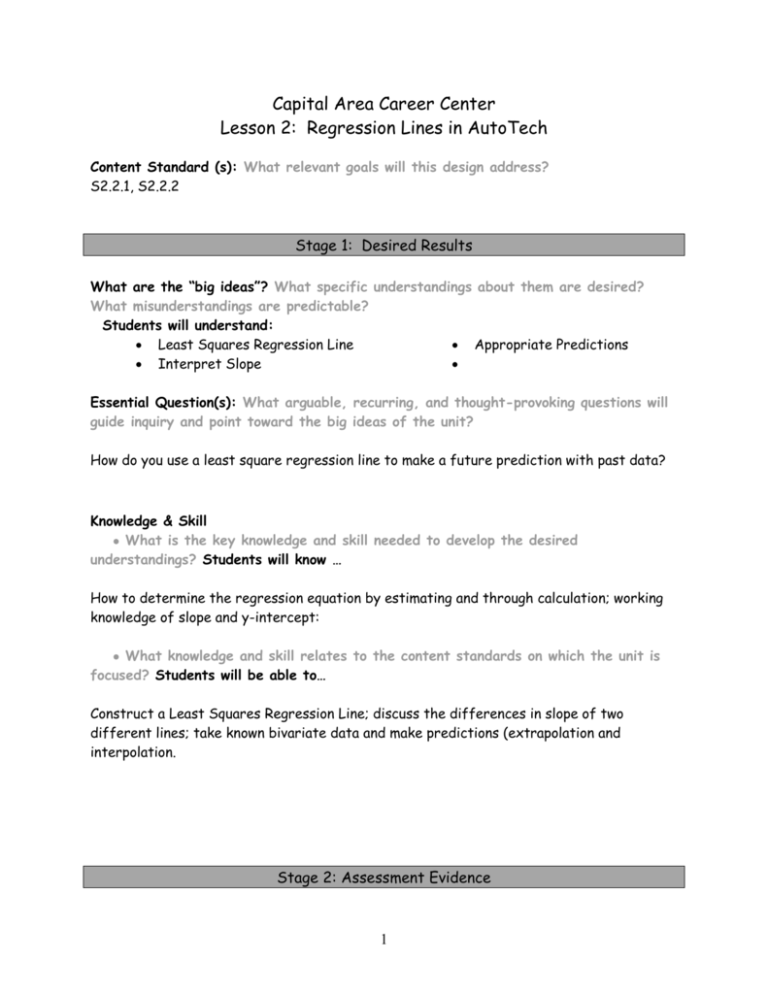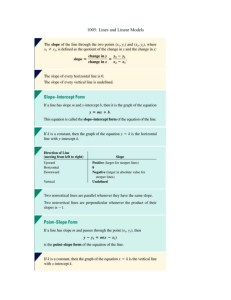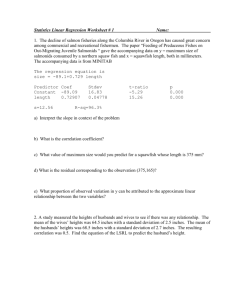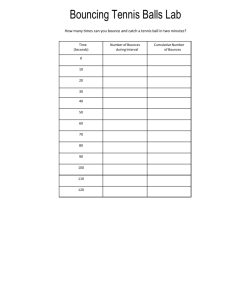Understanding By Design Template
advertisement

Capital Area Career Center Lesson 2: Regression Lines in AutoTech Content Standard (s): What relevant goals will this design address? S2.2.1, S2.2.2 Stage 1: Desired Results What are the “big ideas”? What specific understandings about them are desired? What misunderstandings are predictable? Students will understand: Least Squares Regression Line Appropriate Predictions Interpret Slope Essential Question(s): What arguable, recurring, and thought-provoking questions will guide inquiry and point toward the big ideas of the unit? How do you use a least square regression line to make a future prediction with past data? Knowledge & Skill What is the key knowledge and skill needed to develop the desired understandings? Students will know … How to determine the regression equation by estimating and through calculation; working knowledge of slope and y-intercept: What knowledge and skill relates to the content standards on which the unit is focused? Students will be able to… Construct a Least Squares Regression Line; discuss the differences in slope of two different lines; take known bivariate data and make predictions (extrapolation and interpolation. Stage 2: Assessment Evidence 1 What evidence will be collected to determine whether or not the understandings have been developed, the knowledge and skill attained, and the state standards met? [Anchor the work in performance tasks that involve application, supplemented as needed by prompted work, quizzes, observations, etc.] Performance Task Summary: Summary in G.R.A.S.P.S. form Rubric Titles (Key Criteria) Regression Line: Determine using “best fit” criteria, calculate using graphing calculator, Excel, etc. Students will use collected data (in the form of a scatterplot) related to a realworld situation, construct a linear regression line from the scatterplot, analyze the regression line and prepare a report to an audience appropriate for the situation. Slope and y-intercept: Appropriate for the data. Slope and y-intercept calculated from the graph and interpreted in the problem context. Predictions: Are they reasonable given contextual situation? Formative Assessment Summative Assessment Presentation, Authentic, Program Contextual End of Unit/Course, Standardized, CACCwide 2 Stage 3: Learning Activities What sequence of learning activities and teaching will enable students to perform well at the understandings in Stage 2 and thus display evidence of the desired results in stage one? Learning Activities: Consider the W.H.E.R.E.T.O elements: Activity 1: Data Set Points 0 0 0 1 1 2 2 3 3 4 4 5 5 5 6 6 6 Cost 229 420 580 450 575 300 720 654 520 620 700 935 650 875 850 570 1100 Using the above data, create a scatterplot. 3 License Points vs. Insurance Costs 1200 1000 Costs 800 600 400 200 0 0 1 2 3 4 5 6 7 Points 1. Draw the best fit line (Least Regression Line). 2. Estimate the Least Squares Regression Line: Use the form y = mx + b, where “m” is the slope and “b” is the y-intercept m = 70, b = 400, y = 70x + 400 3. Using a graphing calculator or Excel, determine the Least Squares Regression Line. Y = 74.308x + 400.57 4 License Points vs. Insurance Costs 1200 1000 y = 74.308x + 400.57 Costs 800 600 400 200 0 0 1 2 3 4 5 6 7 Points 4. a. Using the above Regression Line Equation, what is the y-value (cost) when the x-value (number of points) is 2? (interpolation) 74.308(2) + 400.57 = $549 b. What is the y-value when the x-value is 8? (extrapolation) 74.308(8) + 400.57 = $995 5. Does this Regression Line work for points beyond 8? Beyond 12? 5 Activity 2: Using the information from Lesson 1, Activity 2 or the information below, generate a scatter plot and line of best fit (least squares regression line). RPM Oil Pressure (psi) 500 38 750 37 1000 40 1250 42 1500 41 1750 52 2000 49 2250 55 2500 58 2750 56 3000 64 1. Determine the oil pressure at 1900 rpm. 2. Determine the oil pressure at 3400 rpm. 3. Is there a practical limit to rpm range? What is it? 6 GLOSSARY OF TERMS Least Squares Regression Line: The linear fit that matches the pattern of a set of paired data as closely as possible. Out of all possible linear fits, the least squares regression line is the one that has the smallest possible value for the sum of the squares of the residuals. Slope: Slope is commonly used to describe the measurement of the steepness, incline, gradient, or grade of a straight line. A higher slope value indicates a steeper incline. The slope is defined as the ratio of the "rise" divided by the "run" between two points on a line, in other words, the ratio of the altitude change to the horizontal distance between any two points on the line. It is also always the same thing as how many rises in one run. Carpenters and builders call this ratio the "rise over the run." Using any two points on a line, you can calculate its slope using this formula. Y-intercept: The y-intercept is the point where the graph of a function or relation intercepts the y-axis of the coordinate system. For example, in linear equations that are in the "slope-intercept" form of y = mx + b, the value of b is the yintercept and m is the slope. Interpolation: Interpolation is the process of constructing new points between known points, but its results are often less meaningful, and are subject to greater uncertainty. Extrapolation: Extrapolation is the process of constructing new data points outside a discrete set of known data points. G.R.A.S.P.S. form for performance task: Goal Role Audience Situation Product/Performance/Purpose Standards & Criteria for Success Consider the W.H.E.R.E.T.O. elements for structuring learning activities: 7 Where – Help the students know where the unit is going and what is expected. Help the teacher know where the students are coming from (prior knowledge, interests). Hook – Hook all students and hold their interest. Equip – Equip students, help them experience the key ideas, and explore the issues. Provide – Provide opportunities to rethink and revise their understanding and work. Evaluate – Allow students to evaluate their work and its implications. Tailored – Tailored (personalized) to the different needs, interests, abilities of learners. Organized – Organized to maximize initial and sustained engagement as well as effective learning. 8








